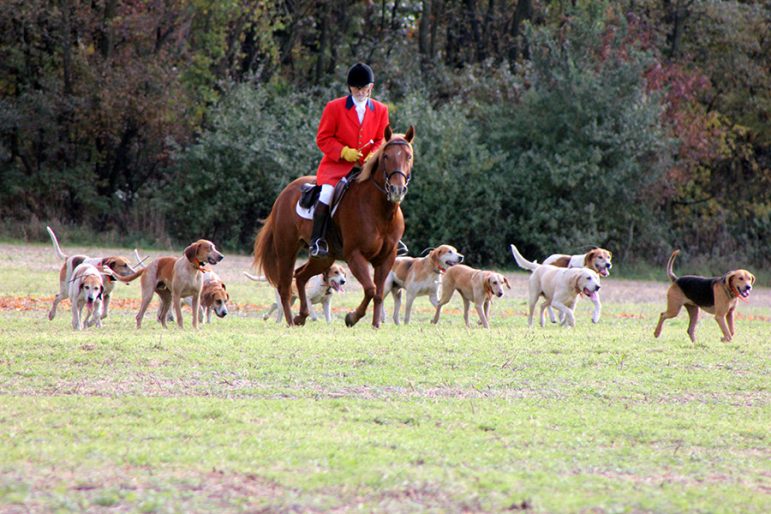
Bob Carr, huntsman of Battle Creek Hunt, rides in a field in Augusta, Michigan with the hunt’s hounds. Photo: Karen Hopper Usher
By Karen Hopper Usher
AUGUSTA, Mich. — From the far side of a plowed-over field comes the sound of a brassy bleat. A red-coated figure astride a small chestnut horse crests a small slope.
The man is Bob Carr, the joint master of foxhounds and huntsman at Battle Creek Hunt. As a joint master of foxhounds, Carr is responsible for hunting operations. As a huntsman, he is in charge of the hounds.
The iconic mounted sport of chasing foxes with hounds lives on in the U.S. and Canada through a club system. The Masters of Foxhound Association has 155 clubs or “member hunts” and around 20,000 foxhunters in the two countries. In the Great Lakes region, there are at least 14 such clubs.
In Michigan, there are three: Battle Creek Hunt in Augusta, Metamora Hunt in Metamora and Waterloo Hunt in Grass Lake.
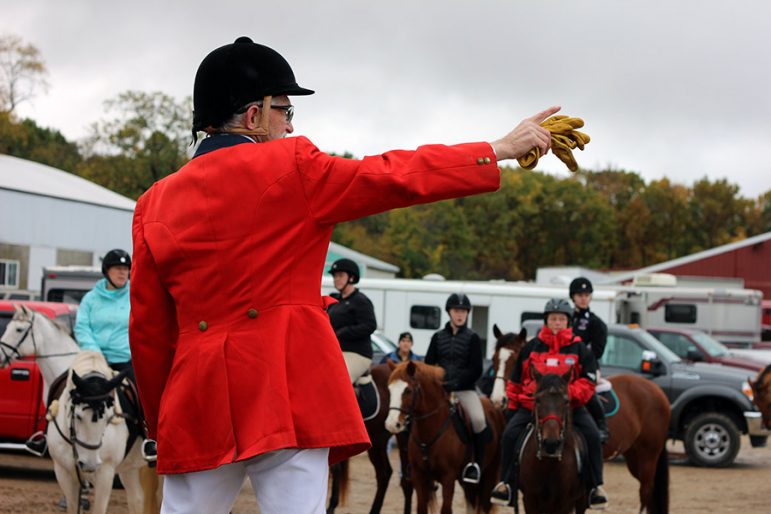
Bob Carr, huntsman and joint-master of foxhounds at Battle Creek Hunt, instructs hunt members and guests before beginning hunting on the hunt’s public day, October 30. Photo: Karen Hopper Usher
The Battle Creek club and its roughly 50 members meet twice a week, September through April at the hunt club’s facility in Augusta. They’ve been there since 1961 after I-94 gobbled up their old territory.
The dogs mill about the feet of Carr’s horse, but are dead quiet because they haven’t sniffed out their quarry.
Hard rain fell all morning, washing away the scent.
A row of horses and their riders–foxhunters–wait at the edge of a field nestled between woods, a road and several houses.
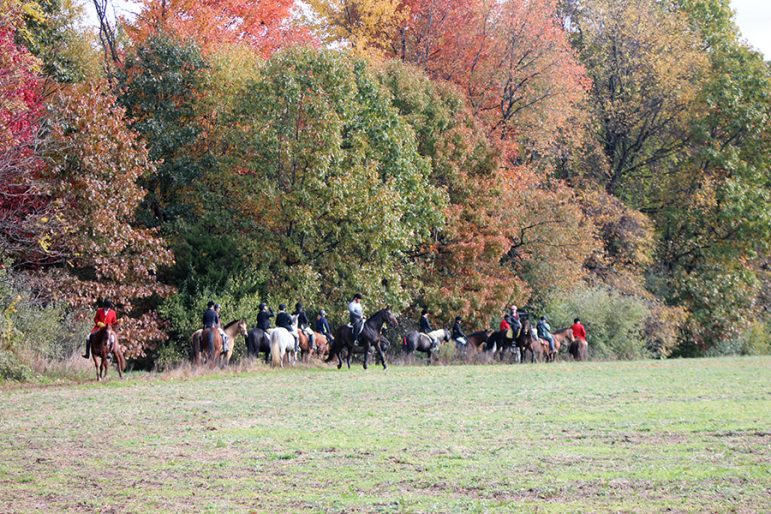
Battle Creek Hunt members and guests wait at the edge of a field while hounds search for fox or coyote scent. Photo: Karen Hopper Usher
They’re there for the chase, if there is one. In return for their hunt membership fees, riders follow the huntsman and hounds through the countryside in pursuit of furry predators. Family membership runs approximately $800, Carr said.
Inside the clubhouse, a red fox is displayed inside a glass case. Its death came not from dog or gun, but from a green Buick. That’s their sole kill, Carr said.
“It’s almost entirely a non-kill sport,” he said.
If their quarry leaves the land they’re permitted to ride on or goes to ground, the chase is over and the hounds are called off.
Despite the name of the sport, if the hounds land on any scent today, it’s probably going to be coyote, not fox.
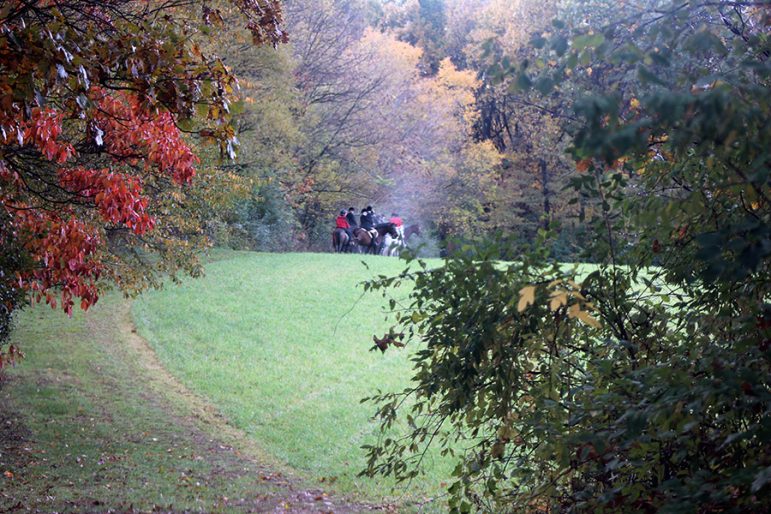
Battle Creek Hunt rides along the edge of a field while fox hunting on October 30. Photo: Karen Hopper Usher
Most hunts chase coyotes because the animal has taken over so much of the country, said Dennis Foster, executive director of the Masters of Foxhounds Association.
In fact, foxes often try to avoid areas where coyote are, said Adam Bump, furbearer specialist with the Michigan Department of Natural Resources, in an email. Coyote see fox as competition for food and will chase or kill them. Foxes in turn move in closer to people, denning under porches and in yards because coyote are less tolerant of humans.
But the kind of quarry isn’t the problem with this sport. Urban sprawl is one of the biggest challenges foxhunters face, Foster said.
The sport is almost entirely dependent on private landowners willing to let foxhunters on their property, Foster said.
And it takes a lot of land.
Battle Creek Hunt currently has permission to hunt 1,500 acres. Their access will eventually shrink when a developer turns an old orchard into houses, Carr said.
The experienced foxhunters know their terrain well.
And their fox-hunting etiquette.
It was in a place they call “Sloppy Hollow” that Kathy Pew got a tiny scolding.
Etiquette calls for riders to be quiet while the hounds are working. But they’d been out for a couple hours, and Pew thought the hunt was over. She started talking to a friend.
“Quiet, please!” somebody said.
The hounds had finally caught a whiff.
That’s about as close as they got that day.
The hounds did “catch a line” at the end, Carr said, but the riders didn’t see the fox.
For serious foxhunters though, that hardly matters.
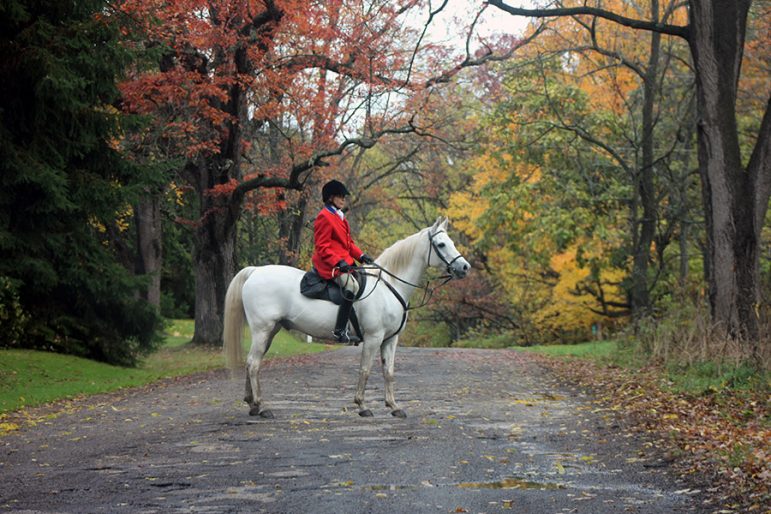
Kathy Taylor, hunt secretary and whipper-in for Battle Creek Hunt, waits for riders and horses to cross North 42nd Street in Augusta. Photo: Karen Hopper Usher
Foxhunting isn’t just a sport. It’s a lifestyle, Foster said. It’s a passion that leads participants to sacrifice other purchases in favor of keeping their horses, decorate their homes with foxhunting art and join new clubs if their old club shutters.
Learn more about Battle Creek Hunt by visiting their website. More information about North American foxhunting is also available at the Masters of Foxhounds Association website.
TALLY HO! Sad this is dying sport. Human population has more than doubled in my lifetime. So has the U.S. population. Population growth is the root of many environmental problems. Evidently, population growth is also an economic engine since there are no political discussions on how to bring it under control.